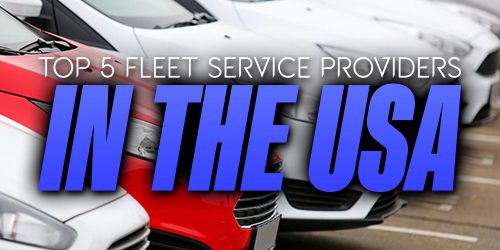
Leasing allows the business to pay for only the portion of the vehicles they use. This reduces the monthly payment when compared to financing a vehicle where you pay and finance 100% of the vehicle and pay tax on the total price.


When compared to gasoline and hybrid vehicles, electric cars have the lowest number of fires per 100,000 sales. Electric vehicles are powered by lithium-ion batteries and EV fires are typically related to the battery. While electric vehicle fires occur less frequently, they burn longer and hotter than other fires. This is due to a chemical reaction in the battery called thermal runaway.

The perfect storm of COVID and the microchip shortage caused a significant drop in new vehicle production which has ultimately led to historical low used vehicle inventory levels.


Storing cargo or tools on work trucks carries with it a certain level of risk. It is often easy to identify vehicles with these types of tools making them prime targets for theft.


Electric vehicle (EV) fleet management requires a different approach compared to managing a fleet of traditional combustion engine vehicles. Here are some best practices for EV fleet management:


The resale value of trucks is a significant component of total cost of ownership and the impactof maintenance on the resale value is often overlooked.

.png)
During the supply chain crisis, the cost of used vehicles increased significantly, and premiums were paid to acquire vehicles. Vehicles in many cases became appreciating assets. However...


The use of telematics has the ability to greatly impact insurance costs, in comes cases—as much as 25%. When a fleet can prove that their drivers have a lower risk...


The Inflation Reduction Act (IRA) replaces the previous $7,500 electric vehicle (EV) tax credit with a system designed to incentivize production and reduce reliance on foreign supply chains. The law has been criticized for its high level of complexity and harder-to-meet eligibility criteria though.


Despite the enthusiasm for electric vehicles (EV’s), there are many hurdles to creating, sustaining and adopting EV’s across North America.


When it comes to football, vehicle shortages and supply chain interruptions, “The best defense is a strong offense,” says a fleet manager for the Tennant Company. The past year or two has been particularly challenging for fleet managers, so many are finding it necessary to employ a variety of tactics in order to stem losses, delays, or added costs.


In November 2021, a panel of EV experts shared their insights at the 2021 Fleet Forward Conference on how others have made the transition towards electrification. Each fleet is unique and requires a customized approach. Here are the key takeaways.


Are you considering converting some of your fleet to electric-powered vehicles? Learned what other fleets have done to make a smooth transition towards electrification.


In November 2021, a panel of EV experts shared their insights at the 2021 Fleet Forward Conference on how others have made the transition towards electrification. Each fleet is unique and requires a customized approach. Here are the key takeaways.


In November 2021, a panel of EV experts shared their insights at the 2021 Fleet Forward Conference on how others have made the transition towards electrification. Each fleet is unique and requires a customized approach. Here are the key takeaways.


The U.S. Energy Information Administration (EIA) predicts a one percent per year growth until 2050 for light-duty electric vehicles (LDV). LDV is defined as “passenger and fleet cars and trucks with a gross vehicle weight rating of 8,500 pounds or less.” This segment is expected to increase from today’s .7% to 31% by 2050!


Recently, the quarterly Manheim Used Vehicle Value InThe Corporate Electric Vehicle Alliance, which includes members such as Best Buy, Amazon, and DHL, recently met with top vehicle manufacturers to outline a roadmap for the types of electric vehicles they plan to acquire over the next five years.


Recently, the quarterly Manheim Used Vehicle Value Index call was held to review market performance from the end of 2021 and the market view going into 2022. A key topic of discussion: Has the significant increase in used vehicle prices set the market up for a crash in 2022?


GPS technology and other telematics provide actionable fleet intelligence technology that delivers real-time insights and help with overall fleet management. Extending fleet life is one such benefit, and is achieved by monitoring usage, hours and driving habits which can better inform lifecycle management.


The 2020 pandemic had far-reaching impacts to including the downward trend of car and truck maintenance costs while vehicles sat idle and were not driven during many of the work-from-home mandates. With efforts to restore the economy, fleets are facing increased maintenance challenges.


Uplifting vehicles has a market value projected at $290 billion for light-duty vehicles and $390 billion for the medium and heavy-duty aftermarket products in 2021. Determining the right uplift or feature to add is critical for optimizing fleet management.


Vehicle inventory continues to be tight and in July 2021, a new record was set for the average listing price of used vehicles.


It has been a challenge finding the right vehicles due to supply chain issues in the automotive industry. There are several issues causing a shortage of vehicles. The biggest contributor to the shortage is the smallest part… a chip. But there is much more to it now. Read on…


Data is increasingly driving the evolution of electric vehicles. Initially, EV’s early adopters were driven by feeling but the reality of EV’s is clear and the data easily supports it.


Reducing vehicle downtime is a critical issue for fleet managers. Inconvenient breakdowns and delays impacting the customer are detrimental to business. Overloading a vehicle and lack of use of vehicles and vehicle equipment can have noticeable impacts across the fleet. Investing in technology is also important in order to track preventive maintenance, collect data track the timely completion of work.


Ford has started announcing more details on its 2022 F-150 Lightning, with targeted horsepower of 563, and the most torque of any F-150 yet at 775 lb-ft. The vehicle is expected to roll off production lines in early 2022 and is a part of the company’s global electric vehicle plan.


In May 2021, used-vehicle values hit an all-time high—but supply stabilized to levels below what had been seen in 2019 and 2020. Used car prices are 15% higher than what was seen in 2019, and 16% higher than 2020 levels.


At face value, an easy way to cut down on capital expenditures it often to defer asset replacements. The problem with this approach though, is that it doesn’t actually achieve the intended goal of cost cutting, but instead shifts expenses to the fixed and operating categories, has vehicles operating outside of the warranty period and creates increased risk for unbudgeted costs.


At face value, an easy way to cut down on capital expenditures it often to defer asset replacements. The problem with this approach though, is that it doesn’t actually achieve the intended goal of cost cutting, but instead shifts expenses to the fixed and operating categories, has vehicles operating outside of the warranty period and creates increased risk for unbudgeted costs.


The new Endurance Alpha Truck is a new all-electric, full-size pickup truck designed specifically for fleets and commercial users, that is still a prototype but gaining a lot of media attention. This new vehicle is still on track to begin deliveries in mid-September, with full production in 2022.


“The number of medium- and heavy-duty electric fleet vehicles sold is expected to grow by more than 100% from 2020 to 2021,” underscoring that the shift to fleet electrification is happening now on a broad scale and expected to accelerate in the years to come.


“The number of medium- and heavy-duty electric fleet vehicles sold is expected to grow by more than 100% from 2020 to 2021,” underscoring that the shift to fleet electrification is happening now on a broad scale and expected to accelerate in the years to come.


The U.S. took one step closer to commercial drone aviation last week with the approval to a company to operate its drones without direct human supervision and without keeping the drone in sight.


President Joe Biden has just announced that he will replace the entire US federal fleet with electric vehicles made in the US.


General Motors plans to achieve carbon neutrality for its global products and operations by 2040, and aspires to eliminate tailpipe emissions from all new light-duty vehicles produced by 2035.


While the past twelve months have presented challenges, Doering took this opportunity to listen to our customers and understand their changing needs.


With the changing economy, business leasing has become a hot topic. Companies are looking for ways to preserve cash and reduce costs. This blog discusses how companies realize real savings when leasing vehicles through a Fleet Management Company (FMC). This blog also discusses the impact the 2020 economic downturn has on the value of vehicles both new and used.


We are all finding ways to adjust and move forward. Now more than ever, our customers are relying on us for stability and support and our team is working hard to find new ways to serve them.


Doering Fleet Management and eIQ Mobility are partnering to provide fleets with seamless EV deployments. eIQ Mobility provides fleets with highly accurate EV Feasibility and Sustainability Assessments using EValuate, their online decision platform.


Doering Fleet Management and eIQ Mobility are partnering to provide fleets with seamless EV deployments. eIQ Mobility provides fleets with highly accurate EV Feasibility and Sustainability Assessments using EValuate ™, their online decision platform.


Doering CEO, JW (Chip) Doering discusses the advantages of working with a fleet management company versus acquiring vehicles on your own through a dealership.


The Doering team understood that Electric Vehicles would soon become intregal to the fleet management industry.

.png)
The sharing economy is slowly changing cultural thinking. More and more people prefer to use rideshare services like Uber or Lyft instead of owning a vehicle. Fast forward several years. Booking use of a vehicle will become the norm, driving up vehicle utilization and driving down the number of vehicles on the road and taking up parking spaces. No longer are we expanding roads and fewer parking structures will be built.

.png)
Electric vehicles sales in the US surpassed one million vehicles in 2018. The consumer traction is significant but fleet and government/municipal sales are growing rapidly. Madison, Wisconsin and New York City are sporting EV taxis. Nashville and Chicago have EV-only black car services. There are good reasons why municipalities and local governments are making the move to electric vehicles.


Doering Fleet Management recently celebrated 30 years in business. A lot has changed over those years but one thing has not. The appreciation we have for our clients has not changed! All of us at Doering genuinely care about our clients and love what we do and for whom we do it!

.png)
Doering Fleet Management recently launched two new websites: a corporate website (DoeringFleet.com) and a Tesla focused website (MyTesLease.com). The new websites were designed to represent their depth of experience, breadth of knowledge, and commitment to client success and satisfaction.


Doering Fleet Management, a nation-wide fleet management company, is expanding its geographic reach by establishing additional regional sales offices. The most recent expansion in August 2019 included a Nashville, TN office and an Oklahoma City, OK office. A Central Plains office in Omaha, NE was opened in early 2018.


Brookfield, WI: Doering Fleet Management, a nation-wide fleet management company, announced the promotion of Adam Berger to President. Doering’s long-time Vice President of Sales - Adam Berger - has become President effective August 1, 2019.


Fleet Management Companies (FMCs) are your advocate and can provide advice on fleet strategy and solutions. FMCs provide companies with important guidance on topics like how long to keep vehicles, which vehicle options make sense, and how to remarket vehicles to maximize sales prices.


Professional leasing and fleet management companies (FMCs) offer an alternative to the dealership experience. By enlisting the services of an FMC, there is a good chance you never have to leave your office! You certainly do not need to enter a dealership.


Do you dread the vehicle buying experience through a dealership? Purchasing vehicles at a dealership can be confusing, high-pressure, and unreasonably time-consuming. It is inconsistent and so is the staff. Dealerships are not your only option, especially if you are buying vehicles for company use.


Car dealerships are designed to do transactions with individuals. Dealerships likely won’t offer a business the proper fleet rebates (which are typically higher than consumer rebates) and don’t have true business lease products available.

.jpg)
Telematics is helping to shape driver behavior with real-time feedback. Nearly everything is more fun if it is organized as a game or competition. Driving is no exception. Gamification of driving safety adds a new dimension and competition (personal and peer) that benefits the company.


The world of transportation is changing rapidly and the change is driven by the technology that has made ridesharing, car-hailing, and vanpooling easy. This sharing economy is forcing businesses to rethink how they utilize vehicles.


Businesses with fleets of 5 to 5,000 work with Fleet Management Company (FMC) experts to save time and money. FMCs have proven strategies to preserve a fleet’s value, maximize resale values, drive significant cost savings, and improve risk management.


The key to a successful implementation of a fleet management program is communication. Change is never easy. In fact, many resist it. That is why it is important to communicate, communicate, communicate what it is that you are trying to accomplish and WHY.


When you lease trucks for your fleet you may be offered what seems like a very attractive program that covers your lease payment as well as your maintenance for one price. This option is called a full-service lease. It is a conventional lease plus a maintenance agreement blended together and inseparable.


With the economy growing and interest rates rising, business leasing has become a hot topic. Companies are realizing the savings gained through leasing. As a result adoption rates are on the rise. Here are the 10 ways a Fleet Management Company (FMC) can help companies realize real savings through vehicle leasing.


We all have a friend or several who had a bad experience leasing. It happens constantly. They go to a dealership looking for a vehicle. They consider leasing at some point. They are given the choice of $800 per month for the vehicle they want if they buy. The term is 60 months or more. They are given an option to lease the same vehicle for $550 for a shorter term! BINGO.


Leasing vehicle fleets effectively and efficiently is simple if you follow five key leasing strategies.1. Select the right lease type and terms for your use. 2. Select the ideal vehicles to optimize total cost of ownership. 3. Time the acquisition of your vehicles to minimize costs. 4. Have an exit plan before you acquire vehicles. 5. Take advantage of the benefits leasing has to offer.


In the following video Adam Berger of Doering Fleet Management explains how he helped an organization that merged five companies and five different fleet management approaches into one cohesive fleet management strategy.


You CAN lease new or used vehicles. Leases pay for depreciation or the difference between the original purchase price and the value of the vehicle at the end of the lease.


Many companies, especially those in the trades, think they damage their vehicles too much to lease. This is completely untrue. Well-written fleet leases account for the value at the end of the lease. The ultimate goal is to plan accordingly on the front end of the lease so the company does not have any negative surprises at the end of the lease.


Accountants who understand the difference between fleet leasing (or open-end leasing) and consumer leasing are tremendous advocates of leasing. Accountants who only understand consumer leasing (or closed-end leasing) are opponents of leasing.


Fleet leases are structured based on utilization and can be written based on 10,000 miles or 50,000 annually. Leasing allows business owners to pay for the portion of the vehicles they use. This naturally reduces monthly payments compared to financing a vehicle where the intent is to build equity.


Leasing allows you to preserve capital, use it for strategic reasons, and deploy capital when opportunities present themselves allowing you to capitalize on those opportunities. Leasing also provides sales tax savings in almost every state and dramatically improved income tax benefits.


Fleet leasing is NOT consumer leasing. Fleet leasing is a financial alternative with a built-in exit strategy. Fleet leases are typically three to five years and are customized based on how you intend to use the vehicles.


Dealerships are not the only option for acquiring vehicles especially if you are acquiring vehicles for fleet use. Professional leasing and fleet management companies (FMCs) offer an alternative to the dealership experiences. If you are already using an FMC you are saving time and money by avoiding the dealership.


Recently, we had a discussion with our service team about what is more important: to be liked or to be trusted. It’s a bit of a chicken or the egg argument because both are important especially when it comes to building long-term relationships with customers.At Doering, we approach our relationships with a couple things in mind.

.jpg)
Most leasing companies offer a “one-pay” or “single-pay” lease. In a single-pay lease, the lessee makes one lump sum payment as opposed to monthly payments spread over the length of the lease. Because the payment is made up front, the total monthly payments are reduced for an interest credit.

.jpg)
With the economy growing and interest rates rising, business leasing has become a hot topic. In fact, almost 30% of new vehicle acquisitions are leased. Companies are realizing the savings gained through leasing. As a result adoption rates are on the rise.


Managing a fleet of vehicles is a job requiring professional attention. Many organizations turn to professional Fleet Management Companies (FMCs) to help them manage their fleet. With any business partnership, fit is critically important.


When you send work crews out on a job do they moan and groan about the vehicles you’ve provided or are they excited by the newer model they get to drive? Are some of your vehicles costing you more than they’re worth because they spend more time in the repair shop than on the job-generating revenue for your business?


Feet managers, controllers, CFO’s, and company executives have discovered fleet solutions provided by third-party fleet management companies (FMCs) help free up time and allow them to focus on the strategic priorities.


Paradigms have shifted. In the past five years, the world of transportation and how people move from place to place has changed rapidly. The future is happening now.The automotive world is colliding with the software world, with the Internet of Things (IoT), and with cell phone providers. Vehicles are more connected – to the internet and to one another.


Company culture is integral to the executive fleet program and culture sets the tone for the program. How flexible is the program when it comes to selection and types of vehicles offered? Is there any consideration for the message the type of vehicle sends to customers and employees?


Maybe your company is growing and you need to expand your fleet. Maybe your vehicles are costing you too much in repair costs and need to be replaced. Well, what do you do?You could go to your bank and use your line of credit or dip into your capital reserves. Or maybe, you could just use someone else’s capital and preserve your own for growth activities.


The ideal time to sell a vehicle is when the depreciation cost and the repair and maintenance costs are at their lowest. This is based on a cost per mile (“CPM”) calculation. The CPM equals the annual cost to operate a vehicle divided by annual miles. The target is to cycle vehicles at the point at which CPM has trended down and begins to uptick.


Is your fleet operating as efficiently as possible? Do you gauge its performance against benchmarks and industry best practices? With the emergence of advanced data analysis and innovative technology within the fleet landscape, such as telematics, AI, and alternative energy sources.


Imagine a world where buying vehicles was fun and you knew you received what you wanted at a great price. Imagine a world where you felt as though you had an ally and advocate in the process who knew your needs and expectations. Imagine a world where you did not feel the information about car buying was stacked against you.


The most impactful of these fleet technologies is telematics. Telematics not only evaluates and records driver behavior, but enhances fleet safety by monitoring road conditions and vehicle upkeep. Telematics technology can improve driver performance and vehicle maintenance dramatically.


Fleet management is a job requiring professional attention. Ensuring you have a firm grip on all aspects can be difficult while running a business. In order to improve your fleet operations, consider what functions should be outsourced and what should be done in-house.


A top strategy for selling fleet vehicles starts years earlier with vehicle selection. Proper maintenance, condition, and cleanliness have a meaningful impact on resale as well.


Establishing a company culture where safety is a priority requires a conscious effort by leadership. Team managers must verify driving habits align with company policies. A plan should include triggers for corrective action related to incidents, infractions, and preventable accidents. This plan should be followed consistently.


A top strategy for selling fleet vehicles starts years earlier with vehicle selection and continues with proper maintenance. Selecting the proper options, colors, and features when acquiring vehicles yields greater returns when selling vehicles at the end of their holding periods.


Twenty-seven percent of greenhouse gas emissions in the U.S. today comes from the transportation sector. Vehicle fleets with a high environmental impact should consider their carbon footprint and institute strategies to reduce emissions. For transportation sectors large and small, evaluating business from an environmental perspective can translate into cost-savings.


Managing a fleet of vehicles internally is time-consuming. As your fleet grows, the administration and management of all the details can be overwhelming. Many fleet managers, controllers, CFO’s, and presidents have discovered fleet services provided by third-party fleet management companies help them focus on the strategic challenges that occur and solve issues that arise.


Operating a fleet internally means spending time and resources maintaining, tracking and administering the fleet. These are valuable resources that should be used to grow the organization, not manage the fleet. We hear many stories from business owners and leaders that are distracted by the challenges of managing their fleet when more pressing business issues deserve attention.


The Memphis News, a special weekly edition of The Daily News, featured Doering Fleet Management in a recent article. The article discusses the future of autonomous, electric vehicles in the automobile industry, prompted by Tesla’s release of their fully electric semi truck.


Corporate wellness programs aim to improve the health of employees. Fleet Wellness is a similar concept aimed to improve the health of your business fleet. This approach is based on the theory that by measuring and managing certain aspects of a vehicle fleet, vehicle fleet performance improves markedly.


Choosing the best company vehicles starts with selecting the best type of vehicle for your use. Do you need pickups or vans? Would a taller profile vehicle work better? Do your vehicles require upfitting such as ladder racks or internal shelving? Is your fleet of vehicles for a sales force? What vehicle works best for their use?


The diminished value paradigm may seem logical, but when it comes to managing the financial impact of an accident, especially when you’re not at fault, opportunities to recoup monetary losses are invaluable. Luckily, you have a resource to reestablish your vehicle’s worth: a diminished value claim.


Part 1 covered vehicle qualification for sales tax exemption using a transportation company.Next, we will discuss how to establish a transportation company and what’s required on an ongoing basis to operate a transportation company.




.png)








